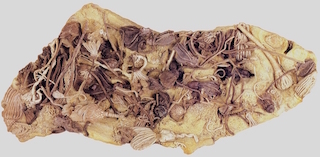
Dozens of crinoids on a slab from the famous quarry in LeGrand.
By John Busbee
Iowa, unlike most states, does not have an official state fossil. But it does have a perfect candidate that has been waiting for 500 million years to fill the role — the crinoid.
The humble, yet exotic fossil is in a class by itself: Crinoidea. Related to starfish and sea urchins, crinoids are fascinating echinoderms (spiny-skinned animals), that look more floral than faunal. They have served as a part of Iowa’s history, scientific legacy and natural industry since Iowa became a state in 1846.
Commonly called “sea lilies” or “feather stars,” its name comes from the Greek words meaning “lily” and “like.” During its heyday hundreds of millions of years ago, crinoids covered the ocean floors. During the Age of Crinoids, Iowa was covered by a vast shallow sea. The fauna of that time featured a diverse representation of crinoids of different shapes, sizes and features. The rich prehistoric life would continue a cycle unbroken for tens of millions of years. The ancient lifeforms, with skeletal parts made of calcareous plates, would die and layer the ocean floor, adding accumulation to what would become Iowa’s now rich deposits of limestone.
Specimens abound
This remarkable invertebrate has survived for half a billion years. Modern crinoids live in South Pacific, Caribbean and Antarctic waters. Iowa’s diverse range of fossil ancestors offers everyman access for finding and collecting their remains. Iowa’s best crinoid specimens also have a hen’s tooth rarity, as top institutions covet having them in their collections and serious collectors prize their best specimens.
The range of fossil crinoids is both humbling and exotic. This animal’s anatomy had a simple functionality, key to its survival. Feed, expel, reproduce. Almost all crinoids were stationary, allowing ocean currents to bring microscopic nourishment to them. Its plating patterns show geometric elegance that is both easily admired, while providing identification traits. A vivid mind could imagine crinoids as Medieval armored creatures of science fiction or fantasy status.
This resilient animal is well represented in Iowa’s paleontology record. Iowa may be the only state where significant specimens have been collected throughout a nearly 200 million-year span, which includes the Silurian, Devonian, Mississippian (The Age of Crinoids) and Pennsylvanian geologic periods.
TO READ THE ENTIRE STORY AND OTHER FASCINATING STORIES ABOUT IOWA HISTORY, subscribe to Iowa History Journal.
